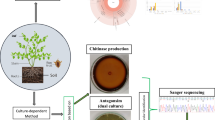Abstract
Yeast communities growing in the decaying tissues (cladodes and fruits) ofOpuntia stricta (prickly pear cactus) and associated yeast vectors (Drosophila species) were compared in two geographic regions (Caribbean and eastern Australia). The Australian yeast community provides an interesting comparison to the Caribbean community, because the host plantO. stricta was introduced to Australia over 100 years ago. Many of the yeasts found in the Australian system also were introduced during a period of biological control (1926–1935) when they accompanied rotting prickly pear cladodes and insects shipped to Australia from the Americas. The yeast community composition (proportion of each species) is compared at several levels of organization: (1) within and between regions, (2) across seasons and years, and (3) within and between tissue types. The yeast species composition of the cladode communities are similar from locality to locality, season to season, and year to year, with the region-to-region similarity slightly less. The composition of the fruit-yeast communities are distinct from region to region and only show some overlap with the cladodes within regions when collected simultaneously in the same locality. It is suggested that the cladode-microorganism-Drosophila system is relatively closed (little extrinsic influence) whereas the fruit-microorganism-Drosophila system is open (large extrinsic influence).
Similar content being viewed by others
References
Barker JSF (1982) Population genetics ofOpuntia breedingDrosophila in Australia. In: Barker JSF, Starmer WT (eds) Ecological genetics and evolution: the cactus-yeast-Drosophila model system. Academic Press, Sydney, Australia, pp 209–224
Barker JSF, Mulley JC (1976) Isozyme variation in natural populations ofDrosophila buzzatii. Evolution 30:213–233
Barker JSF, Toll GL, East PD, Miranda M, Phaff HJ (1983) Heterogeneity of the yeast flora in the breeding sites of cactophilicDrosophila. Can J Microbiol 29:6–14
Barker JSF, East PD, Phaff HJ, Miranda M (1984) The ecology of the yeast flora in necroticOpuntia cacti and of associatedDrosophila in Australia. Microb Ecol 10:379–399
Barnett JS, Payne RW, Yarrow D (1983) Yeasts: characteristics and identification. Cambridge University Press, Cambridge, United Kingdom
Benson L (1982) The cacti of the United States and Canada. Stanford University Press, Stanford, California
Bussey H (1981) Physiology of killer factor in yeast. Adv Microbial Physiol 22:93–122
Dodd AP (1940) The biological campaign against prickly-pear. Government Printer, Brisbane, Queensland, Australia
Garcia Tuduri JC, Martorell LF, Medina Gaud S (1971) Geographical distribution and host plants of the cactus mothCactoblastis cactorum (Berg) in Puerto Rico and the United States Virgin Islands. J Agr Univ Puerto Rico 55:130–134
Lachance MA, Starmer WT (1986) The community concept and the problem of non-trivial characterization of yeast communities. Coenoses 1:21–28
McFayden RE (1985) Larval characteristics ofCactoblastis spp. (Lepidoptera: Pyralidae) and the selection of species for biological control of prickly pears (Opuntia spp.). Bull Ent Res 75: 159–168
Murray ND (1982) Ecology and evolution of theOpuntia-Cactoblastis ecosystem in Australia. In: Barker JSF, Starmer WT (eds) Ecological genetics and evolution: the cactus-yeast-Drosophila model system. Academic Press, Sydney, Australia, pp 17–30
Simmonds FJ, Bennett FD (1966) Biological control ofOpuntia spp. byCactoblastis cactorum in the Leeward Islands (West Indies). Entomophaga 11:183–189
Starmer WT (1981) A comparison ofDrosophila habitats according to the physiological attributes of the associated yeast communities. Evolution 35:38–52
Starmer WT, Phaff HJ (1983) Analysis of the community structure of yeasts associated with the decaying stems of cactus II.Opuntia species. Microb Ecol 9:247–259
Van der Walt JP (1970) Criteria and methods used in classification. In: Lodder J (ed) The yeasts, a taxonomic study. North Holland, Amsterdam, pp 34–113
Author information
Authors and Affiliations
Rights and permissions
About this article
Cite this article
Starmer, W.T., Lachance, M.A. & Phaff, H.J. A comparison of yeast communities found in necrotic tissue of cladodes and fruits ofOpuntia stricta on Islands in the Caribbean Sea and where introduced into Australia. Microb Ecol 14, 179–192 (1987). https://doi.org/10.1007/BF02013022
Issue Date:
DOI: https://doi.org/10.1007/BF02013022




